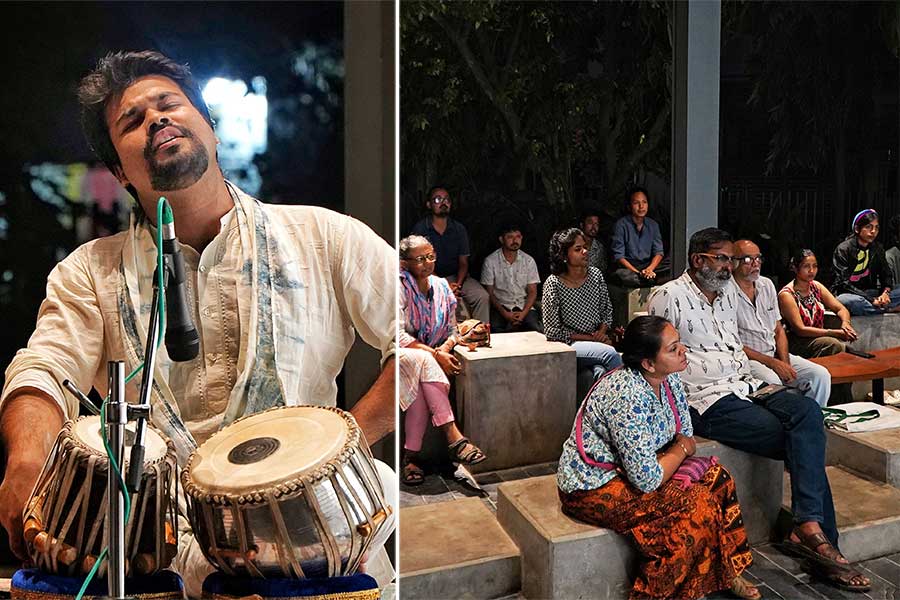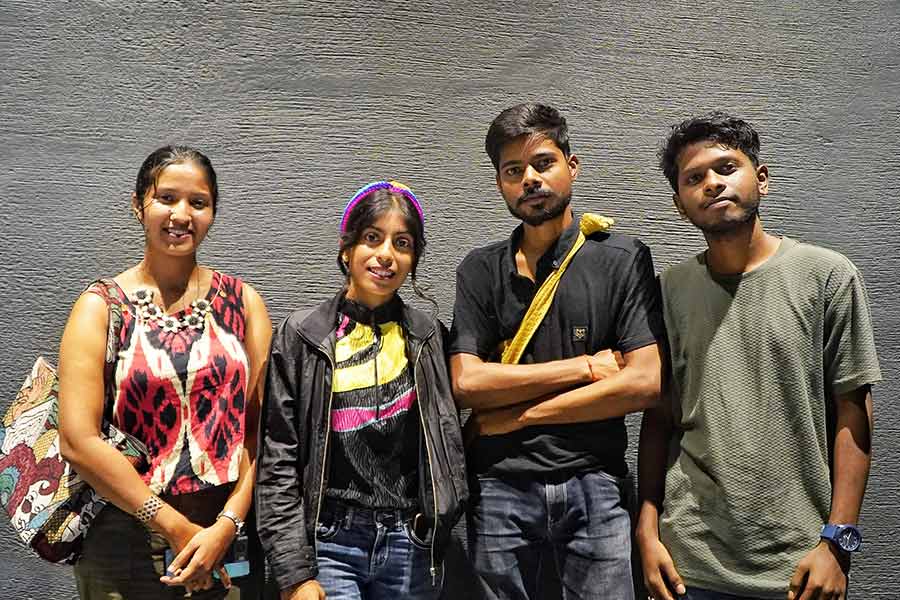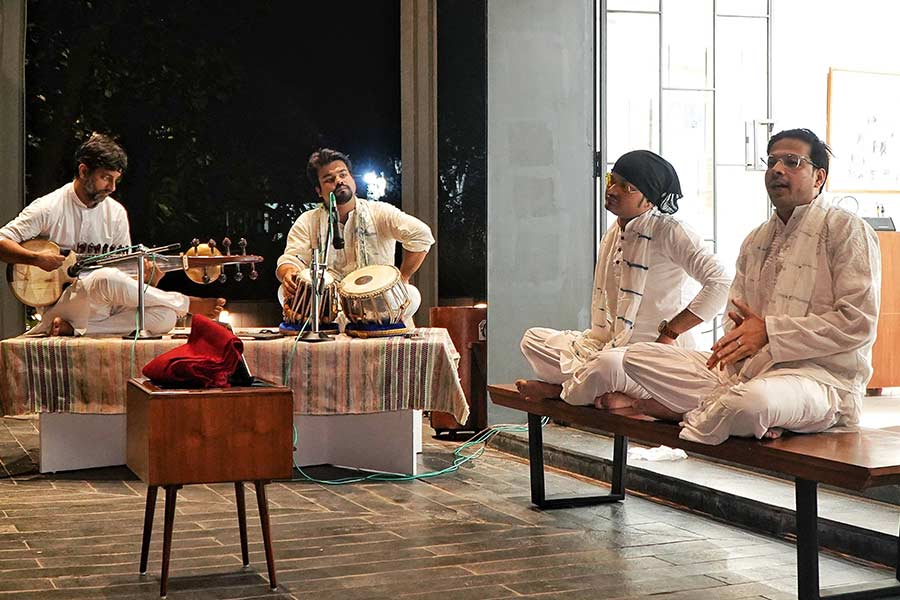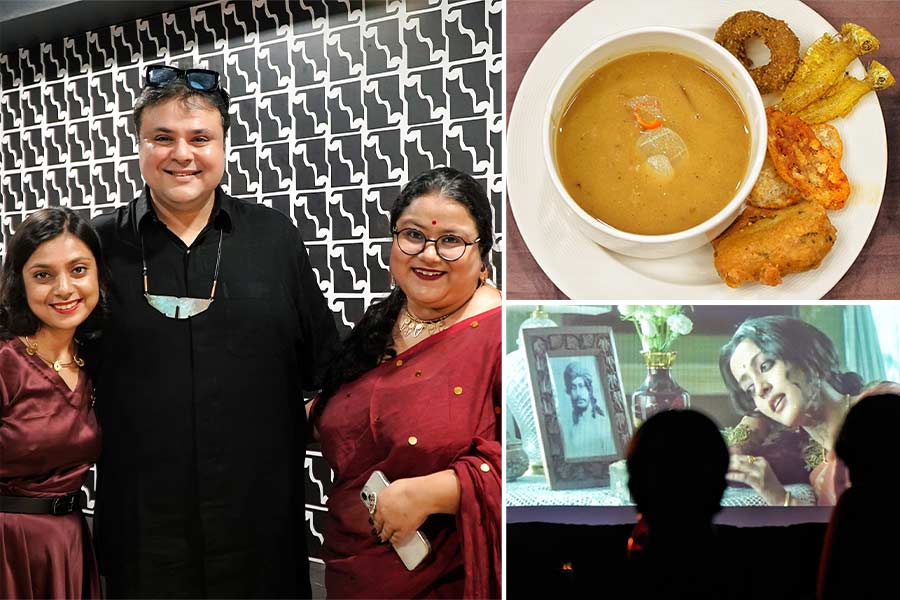Water is a powerful motif in Kolkata, bringing commerce through a river, faith through its banks, and respite through rain. But what role does it play in the story of this great city? The Living Waters Museum collaborated with East India Dastangos to present Kolkata’s rich history through the lens of its water, making every drop count.
Kalkutta ki Jalkatha, held at Arthshila Santiniketan in Bolpur’s Shyambati on November 2, was a performance by Palash Chaturvedi and Zahid Hossain of East India Dastangos that relied on the ancient Persian storytelling style of Dastangoi, blending facts and fables with wit and humour to clue in the audience. The effect was accentuated with beats from the tabla by Sukrit Sen and notes from the sarod by Soumalya Sareshwari.

The highlight of the evening was a rendition of (left) Dhono Dhanyo Pushpe Bhora, compelling the audience to sing along
“This is a dastaan about chalyug, the one that is currently going on. Kolkata is the melting pot of all cultures, and a saga in itself,” Palash said, before commencing the performance. The performers encapsulated the evolution of Kolkata from the merging of three villages; Sutanuti, Kalikata and Gobindapur; the arrival of Job Charnock; the rise of the East India Company; the evolution of life on the banks of Ganga, augmented by its facilitation of trade; and the emergence of the East Kolkata Wetlands as the city’s organic sewage treatment plant. The troupe also drew parallels with how the tiny Kopai river lends a parallel life to Santiniketan, driving home the importance of local water bodies.
Palash also shared a stirring piece, highlighting the benefits of Kolkata’s much-criticised ‘slow life’, “Yahan har ek baat ka chanda hai, yahan fursat bhi ek dhandha hai. Uajam shaam subah se dhalti hai, yahan chaand ki barfi milti hai.”
As the head of the Living Waters Museum’s Kolkata chapter, Sukrit drew attention to how Kolkata had an abundance of water because of its geography, which was in stark contrast to most Indian cities like Bangalore or Mumbai. He also urged the audience to be more mindful of their water consumption, asking them to calculate their ‘water footprint’. “It takes roughly 8,000 litres to make one pair of jeans. So, it is very important that we are thankful for the water that quenches our thirst, because so many places around the world struggle even for this.”

The performance touched the hearts of postgraduate students from Kala Bhavana. ‘The narration especially appealed to the visual artists within us. We were fascinated by how this concept made art mobile, while delivering a strong message,’ said (second from left) Sonu Pujar
Soumalya lauded people from Santiniketan, adding: “Our motive was to reach out to the maximum number of people possible and get this message across in the most accessible way.” This vision has led the Living Waters Museum to perform similar events like Lucknow and Delhi ‘ki Jalkatha’, with a new Mumbai edition coming up for the Kala Ghoda Arts Festival in Mumbai, in January. Zahid added, “Our script and perspective has evolved with every performance. Each set of audience has contributed towards making this piece what it is today.”
Sukrit wrapped up the evening by explaining how, through these performances, there is a vision to create a hybrid museum that isn’t bound to a physical space. “We believe in taking our museum to the people through mediums like this. A performance, be it music or dance, that enlightens people about the importance of water is just as much of a museum as a physical space,” he signed off.



